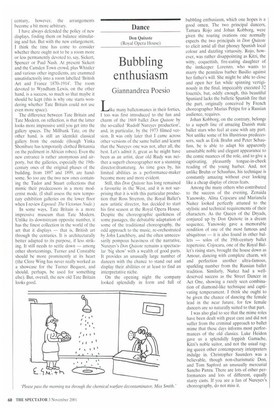Dance
Don Quixote (Royal Opera House)
Bubbling enthusiasm
Giannandrea Poesio
Like many balletomanes in their forties, I too was first introduced to the fun and charm of the 1869 ballet Don Quixote by the so-called 'Rudolf Nureyev production', and, in particular, by the 1973 filmed version. It was only later that I came across other versions of the same ballet and learnt that the Nureyev one was not, after all, the best. Let's admit it, great as he might have been as an artist, dear old Rudy was neither a superb choreographer nor a stunning director/dramaturg. As time goes by, his limited abilities as a performance-maker become more and more evident.
Still, this Don Quixote has long remained a favourite in the West, and it is not surprising that it is with this particular production that Ross Stretton. the Royal Ballet's new artistic director, has decided to start his first season at the Royal Opera House. Despite the choreographic quirkiness of some passages, the debatable adaptation of some of the traditional choreography, the odd approach to the music, re-orchestrated by John Lanchbery, and the often unnecessarily pompous heaviness of the narrative, Nureyev's Don Quixote remains a spectacular 'big show' with a wealth of good parts. It provides an unusually large number of dancers with the chance to stand out and display their abilities or at least to find an interpretative niche.
On the opening night the company looked splendidly in form and full of bubbling enthusiasm, which one hopes is a good omen. The two principal dancers, Tamara Rojo and Johan Kobborg, were given the roaring ovations one normally expects the two principals in Don Quixote to elicit amid all that phoney Spanish local colour and dazzling virtuosity. Rojo, however, was rather disappointing as Kitri, the witty, coquettish, fire-eating daughter of the innkeeper Lorenzo, who wants to marry the penniless barber Basilio against her father's will. She might be able to close and open her fan while spinning vertiginously in the final, impeccably executed 32 fouettes, but, oddly enough, this beautiful Spaniard lacks the balletic Spanish fire that the part, originally conceived by French choreographer Marius Petipa for a Russian audience, requires.
Johan Kobborg, on the contrary, belongs to a superb line of amazing Danish male ballet stars who feel at ease with any part. Not unlike some of his illustrious predecessors, such as Erik Bruhn and Peter Schaufuss, he is able to adapt his apparently unsuitable noble and elegant appearance to the comic nuances of the role, and to give a captivating, pleasantly tongue-in-cheek reading of the young barber. And, not unlike Bruhn or Schaufuss, his technique is constantly amazing without ever looking like a cheap display of circus feats.
Among the many others who contributed to the success of the evening, Zenaida Yanowsky, Alina Cojocaru and Marianela Nufiez looked perfectly attuned to the stylistic and technical requirements of their characters. As the Queen of the Dryads, conjured up by Don Quixote in a dream sequence, Yanowsky gave a memorable rendition of one of the most famous and ubiquitous — it is also found in other ballets — solos of the 19th-century ballet repertoire. Cojocaru, one of the Royal Ballet's rising stars, brought the house down as Amour, dancing with complete charm, wit and perfection another ultra-famous, sparkling number from the Russian ballet tradition. Similarly, Nunez had a welldeserved success as the Street Dancer in Act One, showing a rarely seen combination of diamond-like technique and captivating temperament. I think she ought to be given the chance of dancing the female lead in the near future, for few female dancers are so naturally suited to that part.
I was also glad to see that the mime roles have been dealt with great care and did not suffer from the criminal approach to ballet mime that these days informs most performances of the old classics. Luke Heidon gave us a splendidly foppish Gamache, Kitri's noble suitor, and not the usual raging queen other contemporary interpreters indulge in. Christopher Saunders was a believable, though non-charismatic Don, and Tom Sapford an unusually mercurial Sancho Panza. There are lots of other performances and lots of different, equally starry casts. If you are a fan of Nureyev's choreography, do not miss it.


















































































 Previous page
Previous page